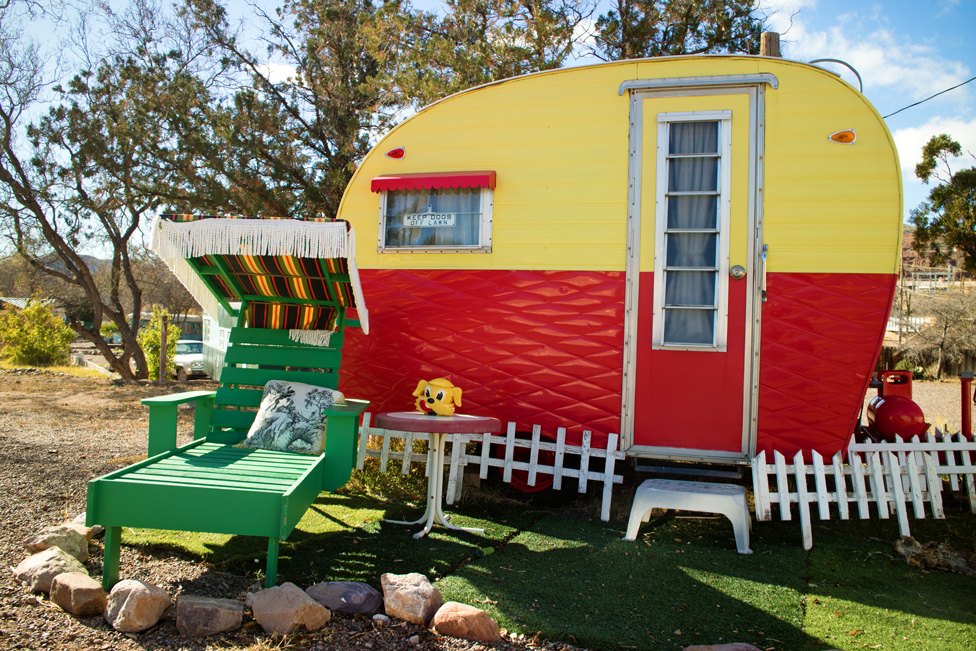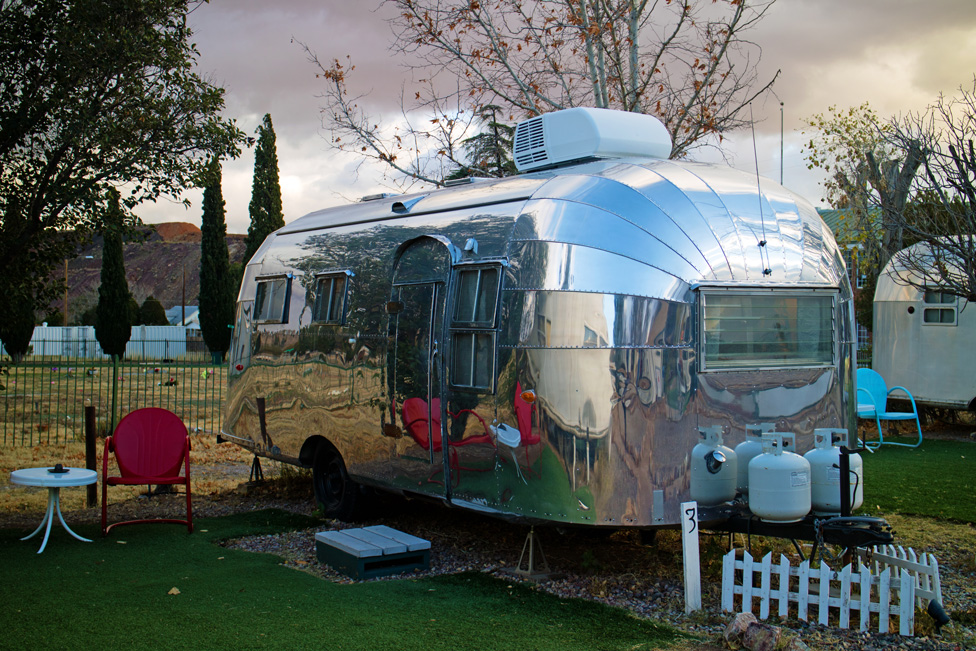The retro bliss of vintage trailer resorts
The Washington Post
By Erin E. Williams
March 8, 2019
“You’ll know yours by the shine,” said Shady Dell Vintage Trailer Court manager Brad Hardy. He was escorting me to my home for the night, a 1955 Airstream. Even though it was built during the Eisenhower era, its polished aluminum exterior gleamed like it had rolled off the factory floor yesterday.
The Airstream was the only model of its kind in a fleet of 10 travel trailers, all dating from 1947 to 1959 and nested under trees and beside tiki statues at the Bisbee, Ariz., resort. Yet even the less iconic trailers were so meticulously renovated, I half expected Frank Sinatra to pull up in a Cadillac and ask me to join him for an egg cream in the Shady Dell’s 1950s-style diner.
My overnight stay was the second of two visits to vintage travel trailer resorts, a road-trip sampling of destinations that feature restored Airstreams and other trailers. They cater to people who are captivated by quirky chic or midcentury design, want to reminisce about bygone Americana or crave a nomadic lifestyle but don’t have the budget or space for their own RV.
In a recent informal tally, I counted nearly 20 retro resorts in nine states from California to Tennessee, with more on the way. Some are rustic, with basic amenities, offbeat themes and kitschy art. Other higher-end retreats provide flat-panel TVs and luxury mattresses, linens and toiletries. Many offer communal spaces: wine bars, pools, bathhouses, fire pits and lawn games.
The first resort I visited is in coastal Seaview, Wash. The Sou’wester Historic Lodge and Vintage Travel Trailer Resort boasts 25 trailers, from a compact Shasta that sleeps one to the African Queen , a tri-level colossus that sleeps eight. The resort also offers cabins, lodge suites, campsites and bring-your-own RV hookups across its three-acre grounds.
During our trip to the Sou’wester last spring, my husband Andrew and I stayed in a 1950s Airstream that reminded me of a metal cocoon. Our friends Margo and Tom joined us with their RV and six rescued Chihuahuas.
Our trailer packed two twin beds, a kitchen, dining table and chairs, half-bathroom and personality into its 30-foot length. A vibrant orange ceiling, walls and floor enveloped the living area, and flower-flecked curtains framed its windows. An original stove promised convenient meal preparation, and wooden cabinets provided more storage than we needed. It felt spacious and supremely livable.
The Sou’wester makes it spectacularly difficult to decide what to do. A tiny blue trailer named the Q-Tea holds an organic teahouse. Wellness activities include meditation, yoga and lectures. Massage and quarterly art exhibitions are available in two trailers. Guests can take art classes including writing workshops, waltz and embroidery. The Sou’wester has even hosted more than 500 artists-in-residence through a nonprofit organization that administers its arts, music and wellness programs.
“We’re more than a hotel,” said Thandi Rosenbaum, who has owned the resort for seven years. “Our heart and soul is the quirkiness of the trailers and the other lodging, but our arts and wellness programs infuse life into what we’re doing.”
We surveyed the shelves inside the Sou’wester’s honor-system thrift store, which was housed in a creamy white 1960s Kenskill trailer with panoramic windows, before hitting the clothing-optional Finnish sauna. We opted for swimsuits — a wise choice, as similarly clad guests sat shoulder to shoulder inside the steamy cedar building.
On the lodge’s wraparound porch, we browsed another store that offers local art, handmade goods and groceries. We stocked up on treats and hosted a little dinner party for Margo, Tom and the dogs.
Afterward, we headed back to the lodge, where the Sou’wester hosts live music most Saturday nights. The four of us squeezed into the room where Lenore, a band based in Portland, Ore., was playing. We stayed for a few songs before snuggling into our respective pods, dry and warm during a nighttime squall.
The next morning, Andrew and I picked our way through the puddles to Margo and Tom’s RV. Margo opened the door, and a furry ball of barking Chihuahuas tumbled onto the grass. It was time to burn some energy.
Like other vintage trailer resorts, the Sou’wester is a prime base for outdoor exploration. With dogs in tow, we walked a couple blocks until we popped over Pacific coastal dunes onto a 28-mile stretch of sand that flanks Southwest Washington’s Long Beach Peninsula . The dogs ran until they were so tired, we had to carry armfuls of zonked Chihuahuas back to our trailers and regretfully pack up.
My reluctance to pry myself out of the Airstream isn’t uncommon. The Sou’wester is meeting growing demand by rolling out two new additions, a 1969 Silver Streak Continental and a 43-foot-long Bluebird bus with a cedar-clad sunken tub. About 15 additional trailers await makeovers and deployment.
“At this point, we don’t have to look for trailers. They find us,” Rosenbaum said. “The restoration requires a master of all trades: mechanical, plumbing, electrical, woodwork, metalwork and design.”
After one night in the Airstream, I was infected with enthusiasm for renovated trailers. In late December, I took a solo trip to Arizona’s Shady Dell, the country’s oldest travel trailer resort, which has been accommodating road-trippers since 1927. Here, Hardy led me to my second Airstream, a 22-foot-long model. He pointed out its kitchen and new vintage-style refrigerator, then opened the door to a tiny nook that contained a toilet and sink.
“Your bathroom is so small, it’s almost comical,” he said. “But you’ll appreciate it in the middle of the night.”
The Western-themed trailer was filled with character. A cactus cookie jar graced the four-burner gas stove. Mexican blankets covered the two twin beds. Cowboy tchotchkes adorned the shelves. A red velvet couch and record player underscored the vintage flair.
Crunching along a gravel path past the other trailers, I admired a bus parked next to its own tiki bar and a permanently moored yacht, both built in 1947. I stepped onto the diner’s classic black-and-white tiles, and sat down on one of the 10 sparkly pink stools alongside a chrome-trimmed counter. Although the diner is only available for guests’ food preparation, the Shady Dell plans to reopen it as a pop-up restaurant that showcases local and regional chefs.
Five minutes down historic Highway 80, I walked through Bisbee’s downtown, nestled in a valley in Southeast Arizona’s Mule Mountains. Bisbee was once famous for mineral and copper mining; the Shady Dell sits across the highway from one of the old mines. I peered into window after window of art galleries, restaurants and specialty shops, including a vegan general store.
By the time I returned to my trailer, the temperature had dropped to below freezing. I turned on a portable heater that warmed the space before I finished cooking dinner, then tucked myself into bed with a pile of blankets. Midway through the night, I awakened with Hardy’s promised appreciation for the small bathroom.
The next morning, I visited the Shady Dell’s two newest acquisitions: a mammoth, 45-foot-long 1955 Kropf and a curvy, red 1950 Alma. Both awaited the painstaking work necessary to transform these neglected hulks into alluring abodes.
When I spoke with the Shady Dell’s owner, Justin Luria, a few weeks later the rejuvenated trailers were available for overnight stays. “The Kropf was a time capsule,” Luria said. “Everything was the original design. It sat in its first owner’s backyard for 70 years.”
Both of these resorts, and others like them, rescue trailers that might otherwise decay or be discarded.
“We restore castoff trailers and keep them going instead of letting them go into the dump,” Luria said. “And we preserve a piece of American highway history that might otherwise be lost.”
I’m ready to do my part to help maintain it, one retro slumber party at a time.
Original at The Washington Post.
PDF here: 2019-03-10 travel trailers.





